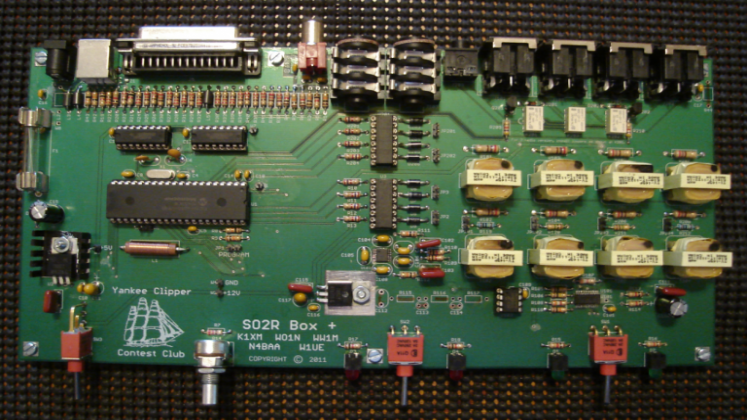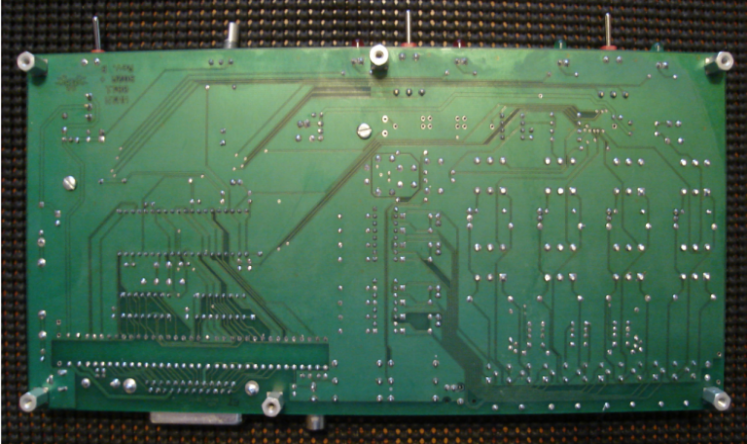Signal Control and Switching The function of the So2r controller box is to provide an automatic switching of key line, PTT and for the AF to/from the rigs. So2r can be implemented for RTTY contesting without a signal controller. But for CW and especially for SSB, it's an important function because the human is doing the decoding instead of the PC. And even if your head can keep the signals straight, the box is still required to send the keying or mic to the proper rig. Unfortunately in my case as a primarily RTTY contester, I was unsure of the real value a So2r box could provide. And because I could not quite decide on what I want a box to do, that made picking a box pretty hard. The PC and N1MM logger handle all the transmit side and decode functions without a So2r box. However, with 2-4 speakers running around me, I had hoped that an So2r box would provide some new options that I had not considered. I do have an idea of using a foot switch to squelch (or attenuate) the AF on other channels so I can focus in on just one of the receivers. But this need is not tied to a transmit/receive sequence as it would be in CW/SSB. It's more random in nature and the need comes most when there are weak signals calling, or in a pileup where you need to get the TX sequence just right based on what you hear from the RX. This function is nothing that a traditional So2r box would be able to address. UPDATE: The switching/routing including the foot-switch has been completed. Link HERE OptionsThere are several So2r controller options available. Homebrew projects, older used popular boxes like the DX Doubler, and the new stuff. Of the new controllers, the two most interesting are the Microham boxes and the YCCC. Microham - I am very happy with the Microham products and use them for the rig interfaces here in the shack now. They are mature and refined, and well supported. So considering a Microham controller was logical. Microham has a number of So2r options including a huge fully integrated unit that would completely replace the digital interfaces and keyer I use now in addition to providing So2r functionality. They also make an add-on box for guys like me with existing digital interfaces and that would be the right choice in this case. However, because I had no real idea of what I really wanted out of a So2r box, I was hesitant to jump in with another Microham. Also, the cost was significant and I did not want to discover later (after learning more about what I really needed) that the Microham box was not a good fit. Unlikely, but possible. YCCC - About the same time I started to looking into this topic, the YCCC box was being offered as a kit with a group buy still open. There are a couple of interesting things about the box, compared to the Microham units, that were interesting in my specific case. First, the box schematic is published. That opened the door to hardware mods and would make integration easier if needed. And secondly, the command structure is open sourced as well - and supported by N1MM. This means that if I were to build another uP based gadget specifically to my needs for RTTY, the details needed to communicate between N1MM and my gadget were easily understood. This last option came to me when reading about the Ardunio So2r board that YCCC came up with. Finally, the YCCC box supports 4 separate rigs as one of the options. I was not sure if that would be important or not but having the versatility seemed a good idea as well. Selection - So after considering the two options, I entered an order for the 4-rig version of the YCCC So2r box thinking that I could sell the unbuilt kit later if I concluded it was the wrong choice. In addition, the cost was much less than the Microham options so even if it sat on the shelf unused, the sunk cost would be less. The YCCC So2r Box The YCCC So2r is a group project of the Yankee Clipper Contest Club. It's sold in a kit form, complete with everything needed to build the kit. The cost of the 4-rig kit including shipping was under $200. Support for voice, cw and digital modes is included. The only lacking item in my thinking was that for FSK specifically, a small interface board is required to contain a set of buffer transistors. I don't use FSK so it was not a problem - and even if I did a small buffer would still be easy to build. But I thought the lack of a few transistors to be an oversight to an otherwise "complete" solution. The So2r box provides 4-rig capability; with any two rigs active at a given time selectable in software. Each rig's key line, AF out and mic input is connected into a single DIN connector. Connectors for the So2r box are provided although the construction of the cables is left for the builder to work out. In the case with my 2K/5K, no further info was required as all of these connections are by clearly marked RCA or 1/4" phono plugs. YCCC SO2R Box home page: http://www.k1xm.org/SO2R/index.html 
The BuildThe kit was complete and went together very easily. The PCB marking stencil is excellent with both component values and part numbers identified. Build time for the So2r box was about 3 hours in my case. And in later tests, the box performed properly the first time. Amazingly I don't think I have any shorts or incorrect part placements - sometimes Murphy is busy elsewhere! Very impressive are the case and PCB. The case is a heavy steel type so it won't move around on the bench which I really like. And in addition to the the PCB marking mentioned above, the board thickness and solder mask were excellent - I'm sure it's the reason I had no solder bridges. I swapped the stock knob with one of my Yaesu stock to give the completed unit a somewhat sister appearance to the rigs. The LED brightness is just right. I have a few homebrew projects in the shack pending LED dimming and I guess you have to be a bit nutty and obsessive to appreciate this detail. 

Using the So2r BoxBuilding the interconnect cables to the rig, determining the resting place for the box and playing with the software setup actually took a lot more time than building the box. Not for doing the actual work - but more thinking about how I wanted to connect the box up! Interconnection with the N1MM logger was simple and explained well in the setup instructions provided via the web. And the feature set contained in the YCCC box complements the function of N1MM nicely. For example, the tilde-key mono/stereo function in N1MM is handy as I prefer the mono setting for CW, and the stereo setting for RTTY. Software adjustments in the So2r Utility application allow for fine-tuning the Winkey emulation and were very much appreciated. My 2K and 5K have very different keying characteristics - with the 2K being a bit light and the 5K being a bit heavy. They can be made to sound the same with a few mouse clicks. That's a reflection of what I believe to be a box built by guys who really do contest work. Integration Challenges Since building the box and playing with it in a couple of contests, it's utility has really been demonstrated. I have made a few other modifications as part of my speaker/key integration. These are documented as part of the Speaker/Paddle Switching page HERE, but those really won't make sense for anyone in the normal use of the box. |